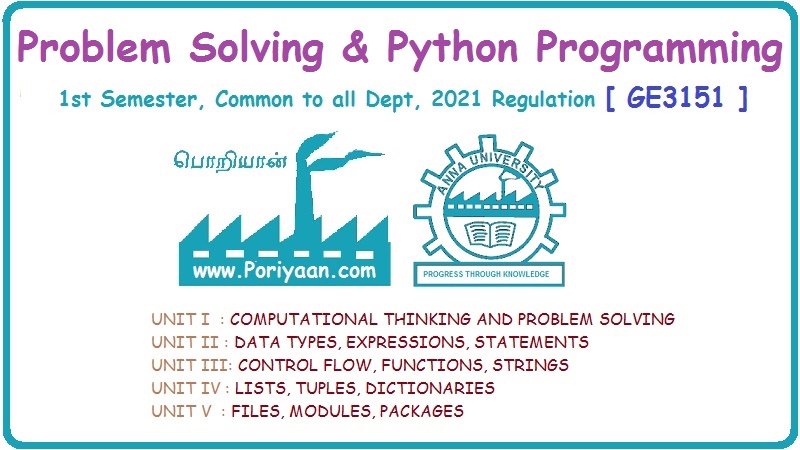Problem Solving and Python Programming: UNIT II: Data Types, Expressions, Statements
Introduction to Python
Features, Uses, History, Future
Python is free and open source programming language. The software can be downloaded and used freely.
Introduction to Python
1. Features of Python
Following
are features of python :
1.
Python is free and open source programming language. The software can be
downloaded and used freely.
2.
It high level programming language.
3.
It is simple and easy to learn.
4.
It is portable. That means python programs can be executed on various platforms
without altering them.
5.
The Python programs do not require compilation, rather they are interpreted.
Internally, Python converts the source code into an intermediate form called
bytecodes and then translates this into the native language of your computer
and then runs it.
6.
It is an object oriented programming language.
7.
It can be embedded within your C or C++ programs.
8.
It is rich set of functionality available in its huge standard library.
9.
Python has a powerful set of built-in data types and easy-to-use
control constructs.
10.
It has rich and supportive community to help the developer while creating new applications.
11.
Using few lines of code many useful applications can be developed using Python.
Uses
of Python in Industry
•
Top companies are using Python as their business application development. Even the
Central Intelligence Agency (CIA) is using Python to maintain their websites.S.
•
Facebook uses the Python language in their production engineering.
•
NASA uses workflow automation tool which is written in Python.
•
B which is a popular telecommunication company who uses Python for its platform
such as S60.
•
The entire stack of Dropbox was written in Python.
•
Quora is a popular social commenting websites which is also written in
Python.
•
Instagram is another website which uses Python for its
front-end.
•
YouTube also uses scripted Python for their websites.
2. History and Future of Python
•
Python is a general purpose programming language.
•
It is high level and object oriented programming language.
•
It was created by Guido van Rossum during 1985 - 1990.
•
Python 3.0 was released in 2008. Although this version is supposed to be
backward incompatibles, later on many of its important features have been
backported to be compatible with version 2.7
Future
of Python
Python
programming language is extensively used for web development, application development,
system administration, developing games and so on.
1)
Artificial Intelligence
•
There are plenty of Python frameworks, libraries, and tools that are
specifically developed to direct Artificial Intelligence to reduce human
efforts with increased accuracy and efficiency for various development
purposes.
•
Machine Learning with Python has made it possible to recognize images, videos,
speech recognition and much more.
2)
Big data
•
The future scope of Python programming language can also be predicted by the way
it has helped big data technology to grow.
•
Python has been successfully contributing in analyzing a large number of data
sets across computer clusters through its high-performance toolkits and
libraries.
3)
Networking
•
Networking is another field in which python has a brighter scope in the future.
•
Python programming language is used to read, write and configure routers and switches
and perform other networking automation tasks in a cost-effective and secure
manner.
Review Question
1. Explain features and uses of Python.
Problem Solving and Python Programming: UNIT II: Data Types, Expressions, Statements : Tag: Engineering Python : Features, Uses, History, Future - Introduction to Python
Related Topics
Related Subjects
Problem Solving and Python Programming
GE3151 1st Semester | 2021 Regulation | 1st Semester Common to all Dept 2021 Regulation
